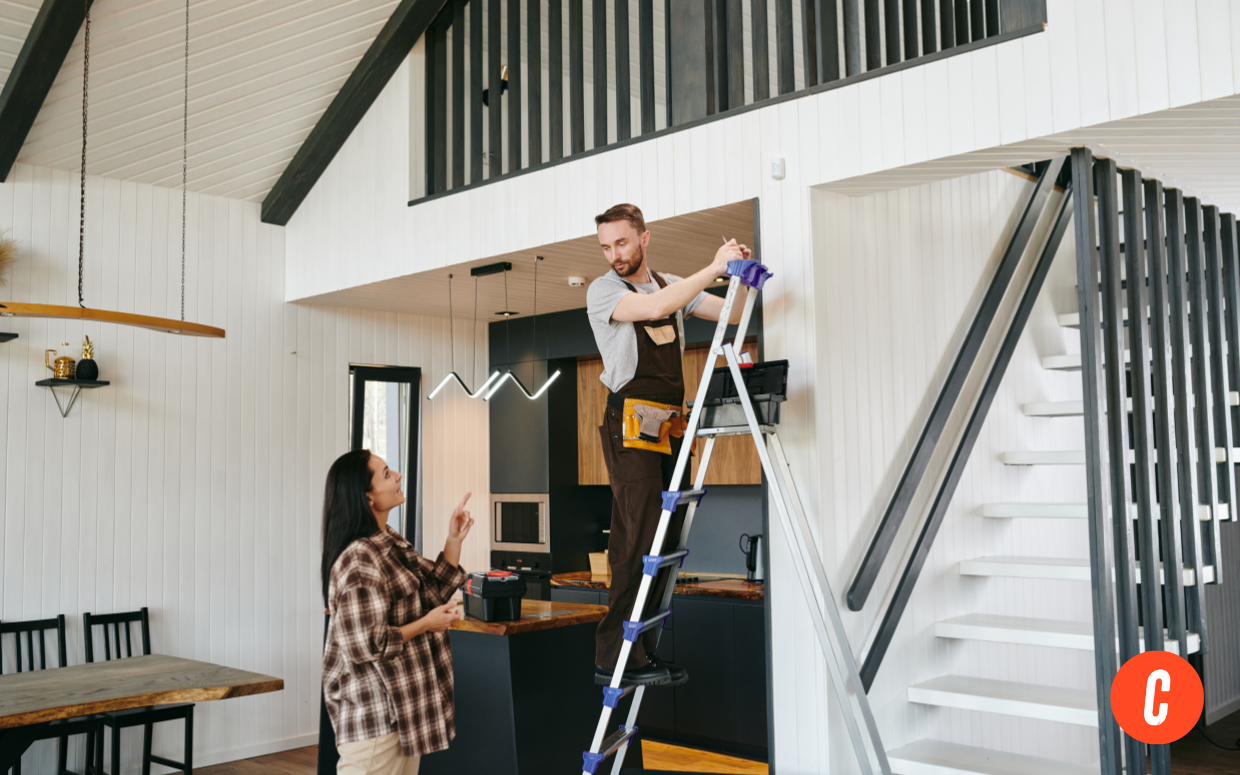Taking care of rental properties means keeping up with maintenance. Landlord responsibilities can become overwhelming, especially if you have multiple properties or are trying to keep up with seasonal changes. A rental property maintenance checklist will make things easier by tracking what needs to be done throughout the year. It’s also a great way to schedule tasks and outsource specific jobs to vendors so you don’t miss anything important. Let’s review the essentials!
Download our free rental property management maintenance pdf checklist so you have all the items you need to prepare. The checklist is organized by timeframes so you can plan your maintenance schedule for the year.

Why Is Regular Property Maintenance Important?
Not keeping your property in its best shape will cost you valuable time, money, and tenants. When your property fails to meet health, safety, and building standards, you may face serious penalties and legal charges from the local and federal government. Here are some reasons why you should perform regular rental property maintenance:
-
Compliance with landlord-tenant laws: Landlords are obligated to ensure their tenants have safe and livable places by keeping up with repairs and maintenance, providing waste management, and making sure common areas are safe. They also have to give notice before inspecting the property.
-
Protect your valuable investments: Neglecting property maintenance can cost more than routine care, impacting your income and return on investment (ROI) when investing in real estate. Damages can lead to tenant complaints, higher turnover, costly repairs, and legal issues.
-
Maintain positive tenant relationships: Delayed property repairs can cause tenants to fix things themselves and take the cost off their rent. In some states, tenants can sue landlords for housing neglect and break leases without notice. To prevent conflicts and legal disputes, maintain your property diligently.
Important Note: The Fair Housing Act prohibits the delay or failure to perform rental maintenance and repairs. This regulation means that landlords should address repairs promptly. Though time requirements vary by state, here are some common real estate investment property maintenance issues and how long a landlord needs to fix them:
- Hot water repair: Within 24 hours
- Air conditioning repairs: 5 to 14 days
- Leaking roof: 30 days
- Refrigerator: 14 to 30 days
- Water system failure: No more than 2 days
- Furnace repair: 3 to 7 days
- Sewage problems: 30 days
Key Features to Include on Your Rental Property Maintenance Checklist

Regular maintenance helps you meet the health and safety standards mandated by the state. You’ll also avoid expensive repairs and emergencies down the line. To keep your rentals in great shape, you’ll need to perform various weekly, monthly, quarterly, seasonal, annual, and unexpected maintenance tasks.
Weekly Maintenance
Weekly maintenance tasks for your property management checklist should focus on taking care of the property’s inside and outside areas. This means picking up trash, cleaning common spaces like entryways, hallways, laundry rooms, and stairwells, and keeping the lawn and garden in check.
Depending on the season, you might need to rake up leaves, mow the lawn, clear away fallen branches, or shovel snow. And don’t forget to pull weeds and water the plants when needed. Take a look at some examples of interior and exterior tasks you should tackle each week for your property maintenance:
-
Interior weekly maintenance: Dust cobwebs, pick up trash, circulars, and flyers, and disinfect common laundry area surfaces
-
Exterior weekly maintenance: Pick up trash, inspect recycling areas, rake leaves, and shovel walkways
-
Supplies: Scrub brush, vacuum, rake, shovel, and trash bags
Monthly Routine Maintenance
Keeping the property clean every week makes it way easier to handle maintenance each month. When it comes to monthly maintenance, focus more on performing inspections and addressing any lingering issues. Even though there might be less to do, these regular inspections help you spot problems you might have missed during the weekly clean-ups. Below are a few examples of property maintenance tasks that should be done monthly:
Quarterly or Seasonal Maintenance
Seasonal preventative maintenance is super important for keeping everything in good shape and making sure your tenants are happy as the weather changes. The specific tasks you need to tackle will depend a lot on where your property is and the climate, but there are some key chores you should do every few months, no matter the season. Examples of seasonal and quarterly maintenance tasks include the following:
Pro Tip: To minimize disruption to your tenants, schedule inspection appointments and communicate clearly about maintenance work, including when it’ll happen and who’s in charge of it. Using your landlord maintenance checklist is a great way to keep your property in shape, checking off everything from the basement to the roof.
Annual Maintenance
Annual maintenance tasks usually only need to be done once a year, but they don’t have to happen all at once. These are often bigger projects, so spread them throughout the year for better efficiency. Like the monthly stuff, a lot of these annual tasks involve inspections when tenants move out at the end of their lease. This will help you spot any damage caused by tenants and take care of repairs when necessary.
Here are some example tasks that should be included in your property manager checklist for annual inspection.
-
Interior weekly maintenance: Clean carpets and repair floors in common areas, clean dryer vents, drain water heaters, and check interior for mold
-
Exterior weekly maintenance: Ensure fire escapes are in working order and clear of obstruction, power wash or paint siding as needed, reseal parking areas as needed, mulch garden beds, and aerate the lawn, seed as needed
Emergency & Non-emergency Repairs
Even with regular maintenance, you might still run into some unexpected damages. These unexpected repairs can come from things like fires, floods, issues with heating systems and water tanks, and stuff caused by tenants. Typically, you have about three to seven days to resolve emergencies and 30 days to take care of non-emergency repairs. Take a look at some examples of emergency and non-emergency maintenance.
-
Emergency repairs: Failed heating systems in cold weather, absence of hot water and drinkable water, non-functional electricity, and inoperable bathroom plumbing
-
Non-emergency repairs: Inoperable ceiling fans, dripping faucets, noisy radiators, and squeaky floors or doors
Pro Tip: If tenants cause more damage than normal wear and tear, you can take those repair costs out of the security deposit. It’s a good idea to keep detailed records to avoid arguments about any damage. You might also want to include a tenant maintenance checklist in your records.

It’s essential to have a streamlined system when tracking everything for your rental properties. A property management software platform like Baselane helps you manage expenses, including maintenance and repairs, advertising, and commissions. With Baselane, you’ll gain access to automated tools, actionable data, and dedicated financial services designed just for you.
When Should You Do Property Maintenance Inspections?
You should perform property inspections multiple times per year as long as they’re not done randomly and don’t interfere with the tenant’s fair use of the property. To guarantee that the property is always at its best, you should also conduct inspections when a tenant moves in, for routine maintenance, emergencies, and when a tenant moves out. Timely inspections are vital in preventing vacancies and lost rental income.
Pro Tip: If you plan to perform DIY maintenance on your rental property, it’s important to figure out what you can handle and what might need a pro. Generally, anything that requires a license should be left to the experts. If you’re short on time or live far from the property, you should keep a property maintenance services list on hand for emergencies.
Cost of Property Maintenance
Keeping your rental property safe and hazard-free means having a solid maintenance budget in place. If you skip this step, repairs can fall behind, and you could end up spending more later on. Look at past receipts and maintenance records to help you figure out estimated repair costs, or use a simple formula to get a ballpark figure. Here are some formulas landlords use to estimate rental property maintenance expenses:
- 1% rule: Maintenance costs about 1% of the property value per year
- 50% rule: Maintenance and repairs are equal to 50% of your total operating costs
- 1.5x rule: Maintenance costs average 1.5x monthly rental income
- Square foot formula: Maintenance will cost about $1 per square foot per year
Frequently Asked Questions (FAQs)
What is a maintenance walk-through?
A maintenance walk-through is when landlords or property managers inspect a rental property to assess its condition and identify any necessary repairs or maintenance tasks. This walk-through should be conducted regularly, such as before a new tenant moves in or after a tenant moves out, to ensure that the property is well-maintained and up to building code standards. The maintenance walk-through can help landlords and property managers identify potential issues and address them before they become bigger and more costly problems.
Which are considered maintenance expenses for a rental property?
Maintenance expenses for a rental property may include repairs and replacements of broken appliances, plumbing and electrical systems, HVAC systems, painting and cleaning, pest control, landscaping, and any other necessary repairs to keep the property in good condition.
What is a preventive maintenance schedule?
A preventive maintenance schedule ensures a property remains in good condition and prevents equipment failure. It outlines the tasks that need to be performed regularly, such as cleaning the gutters, replacing air filters, inspecting the roofing, and servicing the HVAC system, among others, as well as the frequency at which they should be completed. By following the schedule, property owners and managers can keep their properties in good condition, reduce the likelihood of equipment failure, and save money on costly repairs.
Bringing It All Together
A rental property maintenance checklist pdf helps you keep track of important routine and preventative maintenance tasks, making sure everything stays up to code. This rental property checklist puts all the duties in one handy spot so you can easily plan your weekly, monthly, quarterly, seasonal, and annual maintenance projects, plus any emergency fixes that might pop up.
Do you perform DIY maintenance or outsource your tasks? Let us know in the comments!











Add comment